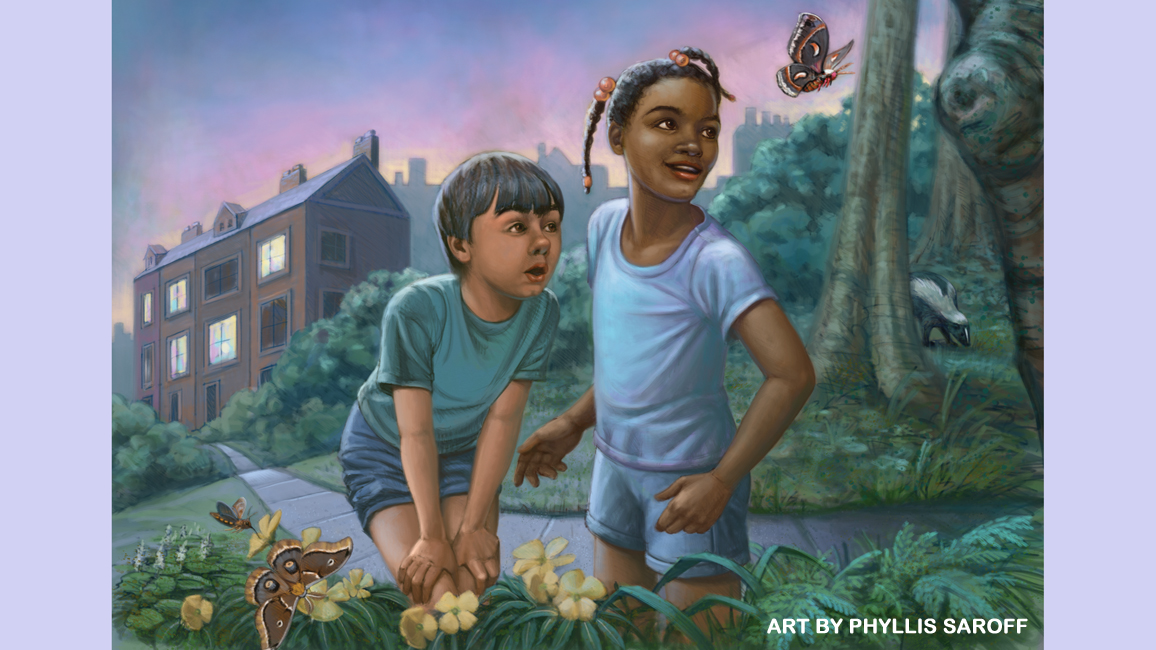
Grow a Night Garden
By Kate Hofmann; Art by Phyllis SaroffWhen the sun sets, some gardens are just getting started!

When you think of a flower garden, what comes to mind? Bright blooms in every color of the rainbow and plenty of sunshine? Butterflies flitting and bees buzzing around? Sure! That’s the daytime garden most of us know, where some flowers close their petals at dusk and insects tuck themselves in for the night.
But there’s another kind of garden—a night garden! This one comes alive as the light fades. Late in the day, the flowers open up. Instead of having bright colors, their petals are white or pale so they show up better in the moonlight. Most have a strong scent to help nighttime pollinators find them in the dark.
THE NIGHT SHIFT
Moths, the nocturnal cousins of butterflies, are the most common night pollinators. As they sip nectar, they move pollen from one night-blooming flower to another. Hawk moths (also known as sphinx moths) are large, fast-flying moths that are sometimes mistaken for hummingbirds.
THE SHOWY ONES
Giant silk moths (such as the beautiful luna moth) are a wonderful treat to see at night, too. They won’t be visiting flowers for nectar, because the adults don’t eat during their short lifespans. But they do fly at night as they look for mates and lay eggs.
SPOTLIGHT: Nocturnal means “active at night.”
GOING BATTY
Nectar-eating bats also may visit night gardens. In the United States, these bats are found only in the deserts of the American Southwest, where they seek out cactuses and other plants with flowers that open at night.
WHOOO ELSE IS AWAKE?
Night-blooming flowers and their pollinators aren’t all you might find in or near a moonlit garden. Fireflies flash. Owls hoot, frogs and toads sing, and crickets and katydids call. Bats zigzag above, nabbing insects out of the air. Flying squirrels glide from tree to tree. Raccoons go looking for food under cover of darkness, and so do opossums and skunks. Keep reading to see the whole scene!

BE A NIGHT GARDENER
Maybe you already have a daytime flower garden at your house but would like to add a night garden. It can be as simple as including one or two night-blooming plants in your garden beds or patio pots. If you have more space, you could create a whole garden focused on night-blooming flowers and their visitors.
HOW TO GROW A NIGHT GARDEN
To attract night pollinators, look for plants that are nativeto your area. Depending on where you live, some native night-bloomers might include:
• evening primrose
• foamflower
• evening snow
• yucca
• agave
• cactuses such as saguaro, organ pipe, and Arizona queen of the night
SPOTLIGHT: Native plants are those that grow naturally in your area. These plants provide the best food and shelter for wildlife where you live. Ask an adult to help you find a local list at nwf.org/nativeplantfinder.
WELCOME THE WILD ONES
If you’re hoping to see giant silk moths such as the luna, cecropia, and polyphemus, your best bet is to include the plants that their caterpillars eat. Female moths will visit these plants to lay their eggs. Many common tree species, including oak, maple, birch, willow, ash, sassafras, and cherry, will attract these insects.
Of course, you’ll want to follow wildlife-friendly gardening practices, too. Never use toxic pesticides or other garden chemicals in your yard. And if you have the space, consider adding a birdbath or pond. Birds aren’t the only ones that will make use of it—insects may also come for a sip. If a pond is large enough, bats may swoop in for a visit.
EXPLORE YOUR NIGHT GARDEN
Now comes the exciting part! After dark, on a night when your flowers are blooming, tiptoe out to your night garden. Don’t turn on a flashlight—just let your eyes adjust to the darkness and soon you’ll see all you need to. Take a deep breath and sniff. Can you smell the strong scent of any of the flowers?
Then look and listen carefully. Have any pollinators or other animals come to visit? Whatever you see or hear, you’re sure to remember this special moonlit garden adventure!
















